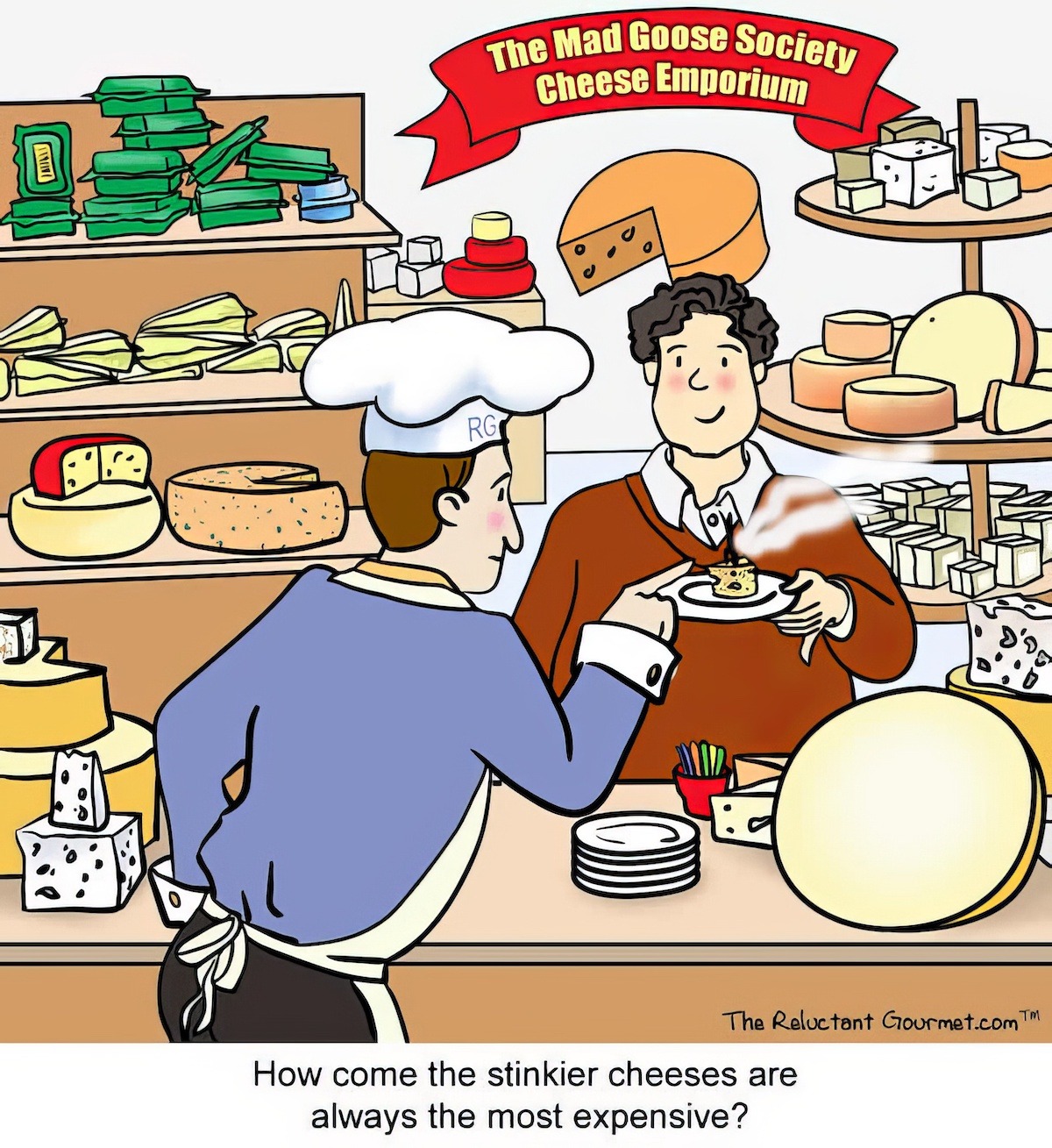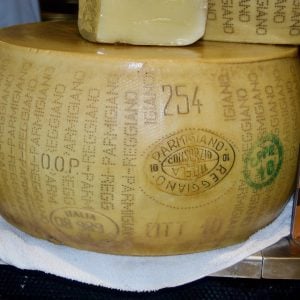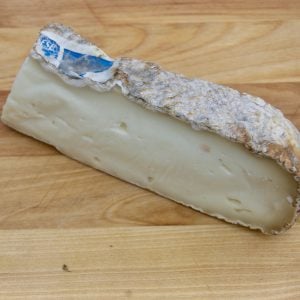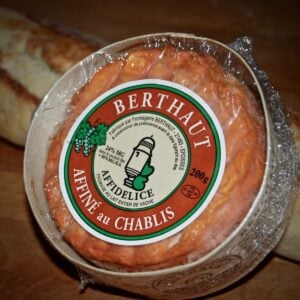Let’s talk about cheese
Regarding cheese, only some people are as passionate or knowledgeable as a skilled cheesemonger. These experts are the unsung heroes behind the counter, carefully curating a selection of cheeses that cater to every palate.
In a recent conversation with Chef David, a cheesemonger, I had the opportunity to dive deep into the fascinating world of cheese – from its complex flavors and textures to the traditions behind its production. The cheesemonger shared insights about the importance of sourcing, aging, and tasting, revealing how each cheese tells a story of its origin, the animals involved, and the meticulous care taken during its creation.
Whether discussing the rich, creamy Brie or the sharp, crumbly cheddar, a cheesemonger’s expertise shines through in their ability to match the right cheese with the right wine or provide recommendations for pairing with other foods.
In this post, I’ll share highlights from our conversation, offering a glimpse into the art and science behind the cheeses we love. Whether you’re a cheese enthusiast or new to the world of artisan cheeses, the tips and tricks offered by a cheesemonger are sure to elevate your cheese experience.
My Experiences
I grew up eating pre-sliced American cheese on my grilled sandwiches, ham and cheese sandwiches, and open-faced broiled tomato and cheese sandwiches (my dad’s version of pizza). Now I serve my 15-month-old daughter slices of American cheese.
She loves it! Some things never change, except today’s American cheese slices come individually wrapped as “cheese food.” What a concept.
As I grew up, I was introduced to cheddar, Swiss, and, because my mom is Scandinavian, a little Danish Blue, which was inedible at the time. Now, I love all those strong-tasting, stinky cheeses, as well as mild ones like Chevre, mozzarella, and my all-time favorite, Explorateur.
The problem I have is with the vast selection of various cheeses. There are so many different styles, textures, and tastes…..how does one decide what to choose?
So I asked my friend David, the cheesemonger at Campagne Specialty Foods, many questions about cheese. I learned from talking with David that you must get out there, taste as many cheeses as possible, and ask many questions.
You won’t like everything you try, but it’s a great way to get a cheese education. Here is my interview with David.

Questions You May Have About Cheese
David, what exactly is a cheesemonger?
A cheesemonger is the cheese department manager in a specialty food shop or cheese shop. Like wine or cooking, becoming an expert in this field requires some formal education and years of tasting and hands-on experience.
This position is typically responsible for all aspects of the cheese inventory: selecting the cheese menu, purchasing, receiving, storing, and ripening.
How should cheese be stored at home?
Cheese should be stored in the refrigerator or on a marble slab in a cool place loosely wrapped, depending on its degree of ripeness and how quickly you want to consume it. Don’t smother the cheese or stuff it in a dark corner, as it needs to breathe.
Wrap the cheese in wax paper or aluminum foil, covering it enough so it doesn’t dry out.
Can you eat the rind of a cheese?
This is a tricky question that is best answered at the shop. For most cheeses, you can eat the rind, but some are very unpleasant to the palate. The rinds from washed-rind cheeses like Liverot, which has an orange-hued color, are generally not eaten.
Can you freeze cheese?
The simple answer to this question is, “No!” (I disagree with David on this question. I always have a chunk of brie and blue cheese in the freezer just in case I need to whip up a Brie appetizer or a blue cheese omelet. RG.)

What should a novice cheese buyer look for when selecting a cheese?
I recommend telling the employees behind the cheese counter what type of cheese you like and asking them for suggestions and tastes. Otherwise, the first question you might ask is what is ripe.
Don’t just go into the cheese shop with many selections before you know what’s good that day. I have built a four-year relationship with the person I buy our cheese from.
I buy some staples that we always have in the shop, but when it comes to the specialties, I tell them to send us whatever is good at the moment. I recommend this same practice when buying cheese from a cheese shop.
How do you know when a cheese is ripe and ready to eat?
You are looking for a perfect aroma, taste, texture, and color balance. This depends on each cheese type and can only be learned by experience or by asking your cheesemonger.
Soft rind cheeses are generally soft to the touch and maybe a little runny inside. Semi-soft and hard cheeses need to be tasted.
How can you prevent buying an overripe cheese?
When cheeses pass their maturation date and become overripe, they become slightly acidic, overpowering for the palate, and unpleasant to consume. However, you can’t always depend on the aroma of cheese to determine its ripeness.
What’s unpleasant to one consumer may be delightful to another.
Always try to taste what you are buying to prevent purchasing an overripe cheese. If you can’t taste the cheese, ask the cheese counter person if it is under-ripe or ripe. A reputable cheese shop should not sell overripe cheese.
What’s the difference in flavor between cow’s milk cheese, sheep’s milk cheese, and goat’s milk cheese?
This depends on the cheese and the process of making the cheese. The flavor is related to the different kinds of milk, but the cheese’s taste depends on the style and how it is produced.
For example, an Italian cow’s milk, Robiola, tastes much stronger than Manchego, a sheep’s milk cheese from Spain.
But another sheep’s milk cheese, Tuma D’La Paja from Italy, tastes much stronger than a St. Nectaire, a cow’s milk cheese from France. Also, the degree of ripeness can affect the flavor of the cheese.
Does hard cheese have more flavor than soft cheese?
Not necessarily. Cheese flavor doesn’t necessarily have anything to do with its texture.
Can someone ask to taste a cheese they want at cheese shops?
It depends on the shop. We encourage tasting the different cheeses we carry in our inventory.
The more different cheeses you taste, the better educated you will become. Tasting cheeses also lets your palette tell you what you like and don’t like.
How about seasons? Are there better cheeses for each season? If so, what are some great cheeses for Spring?
Cheeses do have seasons. The best seasons for making most cheeses are late summer and early fall. This is when the pastures that the animals are grazing on are plentiful with flowers, herbs, and clover.
The best time for purchasing cheese depends on how long it takes to ripen after it is made. Each cheese has a different ripening period.
For example, Camembert and Brie take one to two months to ripen, while Semi-hard cheeses like Fontina, Gruyere, and Emmental take 4-5 months. Hard cheeses, like Parmesan, take 9-18 months to age.
What about the rest of the year?
You can purchase great-tasting cheeses year-round; however, there is a subtle difference between cheeses made from pastured animals and those made from grain-fed milk.
Noticing this subtle difference takes time and experience. The best cheeses for Spring are very young fresh cheeses instead of aged cheeses. Freshly made Mascarpone or chevres would be my pick.
What would you recommend if someone comes into the store and says they are having friends over and want to start with different cheeses?
I recommend a more extensive selection of different cheeses cut into smaller pieces. It’s more fun to taste different cheeses than just having one or two large pieces. Five is a good number.
Cheeses are divided into simple categories. It is most interesting to make a selection that considers Country of origin, Type of Milk, Processing, Texture, Shape, Size, Color, Flavor, Aroma, and Rinse.
Pick cheeses in different categories. That’s why it’s good to buy cheeses at a store where you can taste a variety of cheeses and have smaller amounts cut to order.
What do you suggest serving with cheese?
There are several items you can serve with cheese. Each will bring out different flavors of the cheese. We offer crostini crackers and slices of Volker’s Bakery plain country bread.
You may also serve other accompaniments like olives, cured meats, fruits, and nuts.
What are your favorite cheeses?
I have many favorites in the different categories. It’s hard to choose when there are over a thousand different cheeses, but if cornered, I would choose Tuma D’La Paja, a sheep’s milk cheese from Piedmont in Italy, St. Marcellan from France when it is perfectly ripe, and Montbriac, which is a blue-veined camembert style cheese from France.
David, thanks for the interview.













6 Responses
Great, answered my question about a runny soft cheese I got that seemed over-ripe. I pared it back a bit, where the rind was wet and it’s off to the races with some low-fat crackers. Thanks for writing this useful and concise interview, and thanks to the cheesemonger, too, for sharing!
I made some Jack for the first time in Jan.. aged it till end of March . Came out more like feta, dry and sharp. Did I age it to long? press it with to much.pressure? As I think of Jack as smooth and mild this has the texture of cheddar.
i need a substitute cheese for Tuma Cheese. Tuma is only available at Easter time and even then very difficult to find. What may I use as a so called replacement for tuma please…… very important.
Thank you
.
Hi Mary-Lou, I did a little research and found provolone may be a decent substitute. I’ll see what else I can find out.
Around 60 years ago. My mother took me to small meat market in Texas. They had a large round red waxed cloth covered longhorn cheese. Is this type of cheese stil around somewhere? Thanks. From Dalles
Hi Michael, according to cheese.com, “Longhorn is a style of American Colby cheese defined by its round, long, orange cylindrical shape. When cut for packaging it resembles a moon or shalf moon. It is made from cow’s milk rather than sheep’s or goat’s milk. The flavour can be anything from mild to sharp but it is usually a Colby or Jack cheese. Although, all Longhorn cheeses are shaped and packaged the same way, the texture and aging time may vary depending on the cheese type.” According to LeaveTV’s website, “Longhorn is a shape of cheese. Cheddar is a subcategory of cheese. However, the term longhorn commonly refers to mild, processed American cheddar cheese.” A little confusing but it looks like mild, processed orange cheese with the right shape can be called Longhorn.